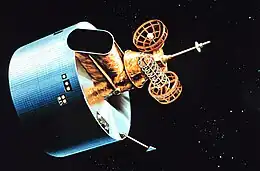GOES 7
GOES-7, known as GOES-H before becoming operational, is an American satellite. It was originally built as a weather satellite, and formed part of the US National Oceanic and Atmospheric Administration's Geostationary Operational Environmental Satellite system. Originally built as a ground spare,[1] GOES-H was launched in 1987 due to delays with the next series of satellites. It was operated by NOAA until 1999, before being leased to Peacesat, who use it as a communications satellite.[2] As of 2009, it was operational over the Pacific Ocean, providing communications for the Pacific Islands. On April 12, 2012, the spacecraft was finally decommissioned and moved to a graveyard orbit.[3]
 Artist's impression of a GOES-D series satellite | |
| Mission type | Weather satellite |
|---|---|
| Operator | NOAA / NASA (1987-1999) Peacesat (1999-2012) |
| COSPAR ID | 1987-022A |
| SATCAT no. | 17561 |
| Mission duration | 3-7 years (planned) 25 years (achieved) |
| Spacecraft properties | |
| Bus | HS-371 |
| Manufacturer | Hughes |
| Start of mission | |
| Launch date | 26 February 1987, 23:05 UTC |
| Rocket | Delta 3914 |
| Launch site | Cape Canaveral LC-17A |
| Contractor | McDonnell Douglas |
| End of mission | |
| Disposal | Decommissioned |
| Deactivated | 12 April 2012 |
| Orbital parameters | |
| Reference system | Geocentric |
| Regime | Geostationary |
| Longitude | 75° West (1987-1989) 98° West (1989-1992) 112° West (1992-1995) 135° West (1995-1999) 95° West (1999) 175° West (1999-2012) |
| Slot | GOES-EAST (1987-1989) GOES-WEST (1995-1999) |
| Eccentricity | 0.0002306 |
| Perigee altitude | 35,879 kilometres (22,294 mi) |
| Apogee altitude | 35,898 kilometres (22,306 mi) |
| Inclination | 15.09° |
| Period | 24 hours |
Launch
GOES-H was launched aboard a McDonnell Douglas Delta 3914 rocket, flying from Launch Complex 17A at the Cape Canaveral Air Force Station.[4] The launch occurred at 23:05 GMT on 26 February 1987.[4] The launch had originally been scheduled for late 1986, but was delayed after GOES-G failed to achieve orbit.[5] It was built by Hughes Space and Communications, based on the HS-371 satellite bus,[6] and was the last of five GOES-D series satellites to be launched.[7]
Operations

Following launch, GOES-7 was positioned in geostationary orbit at a longitude of 75° West,[8] where it underwent on-orbit testing before being activated in the GOES-EAST slot of the constellation.
Due to the loss of GOES-G, and delays in the development of the GOES-I series spacecraft, no reserve satellites were available in the late 1980s and early 1990s. After the imager on the GOES-6 satellite failed in 1989, GOES-7 was left as the only operational GOES satellite.[9] It was moved to 98° West to cover the whole of the continental United States. In 1992, Meteosat 3 was leased from Eumetsat to take over GOES-EAST operations, allowing GOES-8 to be moved 112° West. When GOES-8 entered service in 1995, it replaced Meteosat 3, and GOES-7 was moved to the GOES-WEST position at 135° West. It remained in service until its retirement from service in 1996,[10] at which time it was moved to 95° West. It was then transferred to Peacesat, and positioned at 175° West[11][12] until its final retirement and disposal in 2012.
It is the only satellite to have been operated as both GOES-EAST and GOES-WEST in the course of normal operations. GOES-10 has been used as both GOES-EAST and GOES-WEST, however its operations as GOES-EAST were as a backup during an outage of GOES-12, and the satellite was not moved to the GOES-EAST orbital position.
References
- "International Satellite Directory - Hughes Aircraft - GOES". Flight International. 1985-01-12. p. 45.
- "GOES-7 Satellite". Peacesat. Archived from the original on 2009-06-02. Retrieved 2009-06-13.
- "NOAA retires GOES-7 after 25 years as a weather and communications satellite". NOAA News. NOAA. 2012-04-12. Retrieved 2014-06-02.
- McDowell, Jonathan. "Launch Log". Jonathan's Space Page. Retrieved 2009-06-13.
- "Atlas grounding follows Delta failure". Flight International. 1986-05-17. p. 44.
- Krebs, Gunter. "GOES 4, 5, 6, G, 7". Gunter's Space Page. Retrieved 2009-06-13.
- Wade, Mark. "GOES". Encyclopedia Astronautica. Archived from the original on February 21, 2002. Retrieved 2009-06-13.
- Sample, Sharron. "GOES-7". Encyclopedia Astronautica. Archived from the original on 2006-10-04. Retrieved 2009-06-13.
- "GOES 'Fiasco' causes US crisis". Flight International. 1991-07-16. p. 21.
- "GOES-7". ESE 40th Anniversary. NASA. 1999-04-22. Archived from the original on 2006-10-04. Retrieved 2009-06-23.
- "GOES-7 TRANSITIONED TO HAWAII FOR USE BY PEACESAT STATION, NOAA ANNOUNCES". NOAA. 1999-06-15. Archived from the original on 2016-12-11. Retrieved 2009-06-13.
- "GOES-07". TSE. Retrieved 2009-06-13.
